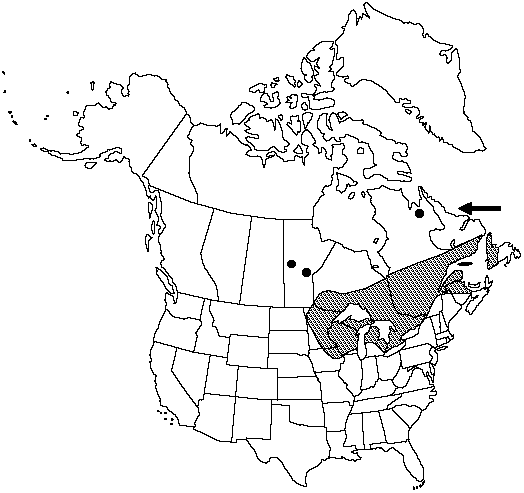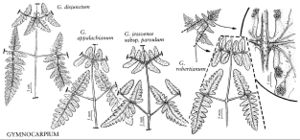FNA>Volume Importer |
FNA>Volume Importer |
| Line 29: |
Line 29: |
| | }}<!-- | | }}<!-- |
| | | | |
| − | --><span class="statement" id="st-d0_s0" data-properties="stem diameter"><b>Stems </b>1–2 mm diam.;</span> <span class="statement" id="st-d0_s1" data-properties="scale some measurement">scales 2–4 mm.</span> <span class="statement" id="st-d0_s2" data-properties="leaf reproduction;leaf some measurement"><b>Fertile </b>leaves usually 10–52 cm.</span> <span class="statement" id="st-d0_s3" data-properties="petiole some measurement;glandular-hair count"><b>Petiole </b>5–33 cm, with numerous glandular-hairs distally;</span> <span class="statement" id="st-d0_s4" data-properties="scale some measurement">scales 2–6 mm.</span> <span class="statement" id="st-d0_s5" data-properties="blade shape;blade shape;blade some measurement;blade texture;blade fragility;abaxial surface architecture or function or pubescence;rachis architecture or function or pubescence;adaxial surface architecture or function or pubescence"><b>Blade </b>broadly deltate, 2–3-pinnate-pinnatifid, 5–19 cm, usually firm and robust, abaxial surface moderately to densely glandular, rachis densely glandular, adaxial surface moderately glandular.</span> <span class="statement" id="st-d0_s6" data-properties="pinna apex shape"><b>Pinna </b>apex acute.</span> <span class="statement" id="st-d0_s7" data-properties="proximal pinna some measurement;proximal pinna orientation;pinnule orientation;pinnule orientation"><b>Proximal </b>pinnae 3–13 cm, ± perpendicular to rachis, basiscopic pinnules ± perpendicular to costa;</span> <span class="statement" id="st-d0_s8" data-properties="pinnule orientation;pinnule architecture;pinnule architecture;pinnule shape;pinnule shape;pinnule architecture;pinnulet orientation;pinnulet height or length or size;pinnulet arrangement">basal basiscopic pinnules either sessile or stalked, pinnate-pinnatifid or pinnatifid, if sessile then with basal basiscopic pinnulet usually shorter than adjacent pinnulet;</span> <span class="statement" id="st-d0_s9" data-properties="pinnule orientation;pinnule architecture;pinnule architecture;pinnulet orientation;pinnulet height or length or size;pinnulet variability;pinnulet arrangement">2d basal basiscopic pinnule sometimes stalked, if sessile then with basal basiscopic pinnulet shorter than or equaling adjacent pinnulet;</span> <span class="statement" id="st-d0_s10" data-properties="pinnule orientation;pinnule architecture;pinnule architecture;pinnulet orientation;pinnulet height or length or size;pinnulet variability;pinnulet arrangement">basal acroscopic pinnule sometimes stalked, if sessile then with basal basiscopic pinnulet shorter than or equaling adjacent pinnulet.</span> <span class="statement" id="st-d0_s11" data-properties="pinna architecture;pinna architecture;pinnule orientation;pinnule height or length or size;pinnule arrangement"><b>Pinnae </b>of 2d pair usually stalked, if sessile then with basal basiscopic pinnule usually shorter than adjacent pinnule and equaling basal acroscopic pinnule;</span> <span class="statement" id="st-d0_s12" data-properties="pinnule orientation;pinnule height or length or size;pinnule arrangement;apex architecture or shape;apex shape">basal acroscopic pinnule shorter than adjacent pinnule, apex often entire, rounded.</span> <span class="statement" id="st-d0_s13" data-properties="pinna architecture;pinnule orientation;pinnule height or length or size;pinnule arrangement"><b>Pinnae </b>of 3d pair usually sessile with basal basiscopic pinnule shorter than adjacent pinnule and equaling basal acroscopic pinnule;</span> <span class="statement" id="st-d0_s14" data-properties="pinnule orientation;pinnule variability;pinnule height or length or size;pinnule arrangement">basal acroscopic pinnule equaling or shorter than adjacent pinnule.</span> <span class="statement" id="st-d0_s15" data-properties="ultimate segment shape;ultimate segment shape;ultimate segment shape;ultimate segment shape;apex architecture or shape;apex shape"><b>Ultimate </b>segments of proximal pinnae oblong, entire to slightly crenate, apex entire, rounded.</span> <span class="statement" id="st-d0_s16" data-properties="spore some measurement;2n chromosome count"><b>Spores </b>34–39 µm. <b>2n</b> = 160.</span><!-- | + | --><span class="statement" id="st-undefined" data-properties=""><b>Stems </b>1–2 mm diam.; scales 2–4 mm. <b>Fertile</b> leaves usually 10–52 cm. <b>Petiole</b> 5–33 cm, with numerous glandular hairs distally; scales 2–6 mm. <b>Blade</b> broadly deltate, 2–3-pinnate-pinnatifid, 5–19 cm, usually firm and robust, abaxial surface moderately to densely glandular, rachis densely glandular, adaxial surface moderately glandular. <b>Pinna</b> apex acute. <b>Proximal</b> pinnae 3–13 cm, ± perpendicular to rachis, basiscopic pinnules ± perpendicular to costa; basal basiscopic pinnules either sessile or stalked, pinnate-pinnatifid or pinnatifid, if sessile then with basal basiscopic pinnulet usually shorter than adjacent pinnulet; 2d basal basiscopic pinnule sometimes stalked, if sessile then with basal basiscopic pinnulet shorter than or equaling adjacent pinnulet; basal acroscopic pinnule sometimes stalked, if sessile then with basal basiscopic pinnulet shorter than or equaling adjacent pinnulet. <b>Pinnae</b> of 2d pair usually stalked, if sessile then with basal basiscopic pinnule usually shorter than adjacent pinnule and equaling basal acroscopic pinnule; basal acroscopic pinnule shorter than adjacent pinnule, apex often entire, rounded. <b>Pinnae</b> of 3d pair usually sessile with basal basiscopic pinnule shorter than adjacent pinnule and equaling basal acroscopic pinnule; basal acroscopic pinnule equaling or shorter than adjacent pinnule. <b>Ultimate</b> segments of proximal pinnae oblong, entire to slightly crenate, apex entire, rounded. <b>Spores</b> 34–39 µm. <b>2n</b> = 160.</span><!-- |
| | | | |
| | -->{{Treatment/Body | | -->{{Treatment/Body |
| Line 58: |
Line 58: |
| | |publication year=1851 | | |publication year=1851 |
| | |special status= | | |special status= |
| − | |source xml=https://jpend@bitbucket.org/aafc-mbb/fna-fine-grained-xml.git/src/287ef3db526bd807d435a3c7423ef2df1e951227/V2/V2_42.xml | + | |source xml=https://jpend@bitbucket.org/aafc-mbb/fna-data-curation.git/src/9216fc802291cd3df363fd52122300479582ede7/coarse_grained_fna_xml/V2/V2_42.xml |
| | |genus=Gymnocarpium | | |genus=Gymnocarpium |
| | |species=Gymnocarpium robertianum | | |species=Gymnocarpium robertianum |
| − | |2n chromosome count=160
| |
| − | |abaxial surface architecture or function or pubescence=glandular
| |
| − | |adaxial surface architecture or function or pubescence=glandular
| |
| − | |apex architecture or shape=entire;entire
| |
| − | |apex shape=rounded;rounded
| |
| − | |blade fragility=robust
| |
| − | |blade shape=2-3-pinnate-pinnatifid;deltate
| |
| − | |blade some measurement=5cm;19cm
| |
| − | |blade texture=firm
| |
| − | |glandular-hair count=numerous
| |
| − | |leaf reproduction=fertile
| |
| − | |leaf some measurement=10cm;52cm
| |
| − | |petiole some measurement=5cm;33cm
| |
| − | |pinna apex shape=acute
| |
| − | |pinna architecture=sessile;sessile;stalked
| |
| − | |pinnule architecture=sessile;stalked;sessile;stalked;sessile;stalked;sessile
| |
| − | |pinnule arrangement=adjacent;adjacent;adjacent;adjacent
| |
| − | |pinnule height or length or size=shorter;shorter;shorter;usually shorter
| |
| − | |pinnule orientation=acroscopic;basiscopic;acroscopic;basiscopic;acroscopic;basiscopic;basiscopic;perpendicular;basiscopic
| |
| − | |pinnule shape=pinnatifid;pinnate-pinnatifid
| |
| − | |pinnule variability=equaling
| |
| − | |pinnulet arrangement=adjacent;adjacent;adjacent
| |
| − | |pinnulet height or length or size=shorter;shorter;usually shorter
| |
| − | |pinnulet orientation=basiscopic;basiscopic;basiscopic
| |
| − | |pinnulet variability=equaling;equaling
| |
| − | |proximal pinna orientation=perpendicular
| |
| − | |proximal pinna some measurement=3cm;13cm
| |
| − | |rachis architecture or function or pubescence=glandular
| |
| − | |scale some measurement=2mm;6mm
| |
| − | |spore some measurement=34um;39um
| |
| − | |stem diameter=1mm;2mm
| |
| − | |ultimate segment shape=entire;slightly crenate
| |
| | }}<!-- | | }}<!-- |
| | | | |
| | -->[[Category:Treatment]][[Category:Gymnocarpium]] | | -->[[Category:Treatment]][[Category:Gymnocarpium]] |
Stems 1–2 mm diam.; scales 2–4 mm. Fertile leaves usually 10–52 cm. Petiole 5–33 cm, with numerous glandular hairs distally; scales 2–6 mm. Blade broadly deltate, 2–3-pinnate-pinnatifid, 5–19 cm, usually firm and robust, abaxial surface moderately to densely glandular, rachis densely glandular, adaxial surface moderately glandular. Pinna apex acute. Proximal pinnae 3–13 cm, ± perpendicular to rachis, basiscopic pinnules ± perpendicular to costa; basal basiscopic pinnules either sessile or stalked, pinnate-pinnatifid or pinnatifid, if sessile then with basal basiscopic pinnulet usually shorter than adjacent pinnulet; 2d basal basiscopic pinnule sometimes stalked, if sessile then with basal basiscopic pinnulet shorter than or equaling adjacent pinnulet; basal acroscopic pinnule sometimes stalked, if sessile then with basal basiscopic pinnulet shorter than or equaling adjacent pinnulet. Pinnae of 2d pair usually stalked, if sessile then with basal basiscopic pinnule usually shorter than adjacent pinnule and equaling basal acroscopic pinnule; basal acroscopic pinnule shorter than adjacent pinnule, apex often entire, rounded. Pinnae of 3d pair usually sessile with basal basiscopic pinnule shorter than adjacent pinnule and equaling basal acroscopic pinnule; basal acroscopic pinnule equaling or shorter than adjacent pinnule. Ultimate segments of proximal pinnae oblong, entire to slightly crenate, apex entire, rounded. Spores 34–39 µm. 2n = 160.
Habitat: Calcareous substrates, limestone pavement, outcrops, and cliffs, Thuja swamps
Elevation: 0–1000 m
Distribution
Man., N.B., Nfld., Ont., Que., Iowa, Mich., Minn., Wis., Europe, Asia in Caucasus Mountains.
Discussion
Gymnocarpium robertianum occurs in numerous localities in eastern Canada, especially in Ontario and Quebec where it is widely distributed; populations are small. Hybrids with G. robertianum are extremely rare. Gymnocarpium × heterosporum W. H. Wagner, a putative triploid hybrid between G. robertianum and G. appalachianum, is known only from one county in Pennsylvania (plants now extirpated, K. M. Pryer 1992). Gymnocarpium × achriosporum Sarvela, a putative tetraploid hybrid between G. robertianum and G. dryopteris, is known only from Sweden and two localities in Quebec. Both hybrids resemble G. robertianum in their leaf morphology and dense glandularity but have black, malformed spores.
Selected References
None.

